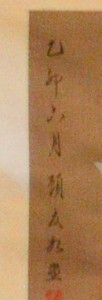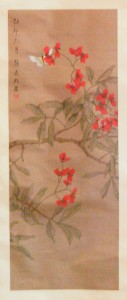Recently, I won a kimono from Yahoo Japan with a mosque around the hem. It hasn’t arrived yet, so I don’t have photos, but it’s absolutely unique and stunning. When I posted about it on the Immortal Geisha forums I got a lot of questions and suggestions about coordination. Several people actually found the same obi on eBay, a deep rusty reddish orange with blue archways on it that had similar Middle-eastern style ornamentation on them. Technically it’s a little casual for the kimono but thematically it would have been perfect. Unfortunately, I’d pretty much blown my budget for a while on the kimono itself, so I had to pass it up.
I should also mention that around the 2010 Holiday season, I organized a gift swap on the forums. Since I was the one arranging it, I wasn’t technically able to participate. In the end I did get a lovely gift from one of the members, due to my own disorganization – I’d accidentally left her out of the swap so I sent her things from my own collection and she graciously sent me a package of lovely handmade things in return.
Fast forward to this morning, when my father informs me that I got “a ton of mail”. I am expecting a few things so I wasn’t terribly perplexed, but when I started opening the package I had no idea what it was. I was worried maybe one of the sellers had mixed up my order, until a note fell out of the package.
Moony, thank you for the work you put into the ImmortalGeisha forums, especially the Winter Swap. You didn’t participate, but here is your surprise gift!
There was no name and no signature, and since several people brought the obi to my attention I really have no idea who sent it! I did make a post on the forums thanking whoever it was and explaining that in the end I did get a package though. ~.~;; In any case, it’s stunning and very appreciated, and will be cherished. I can’t wait for the kimono to arrive so I can put them on together.







































 Bebe Taian
Bebe Taian CHOKO Blog
CHOKO Blog Gion Kobu
Gion Kobu